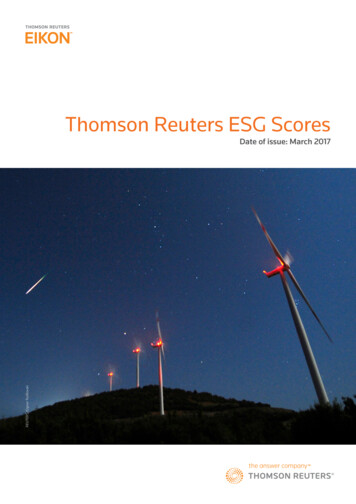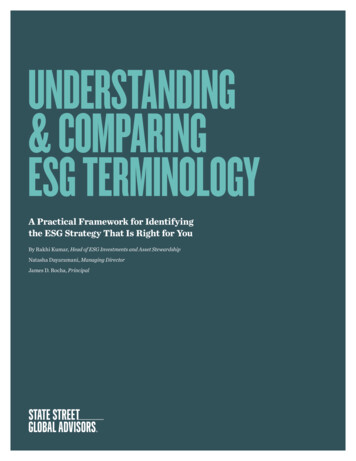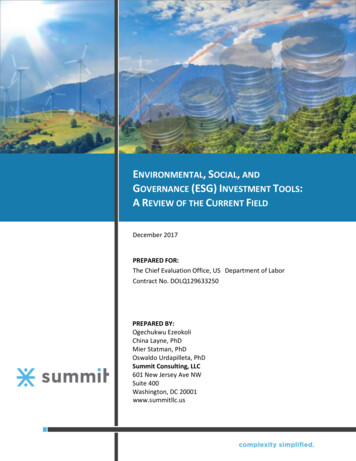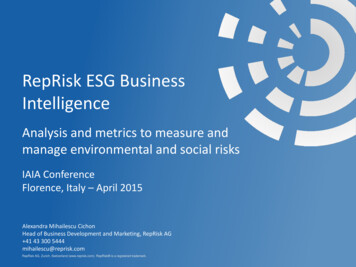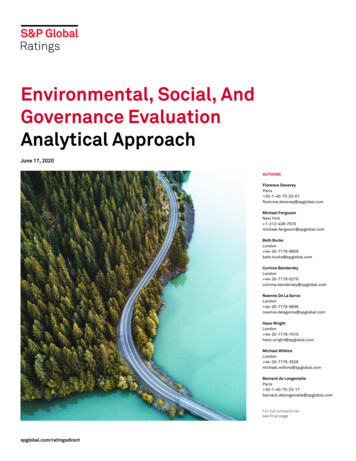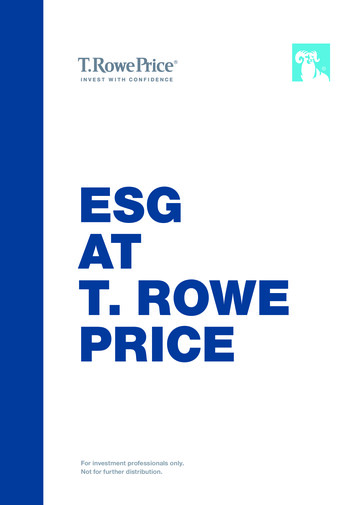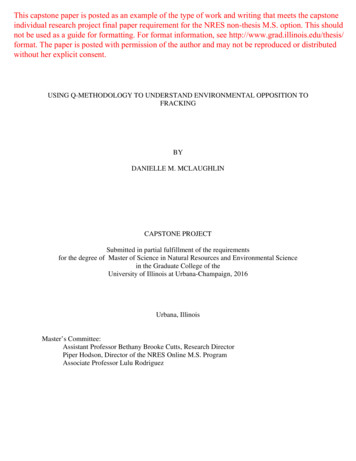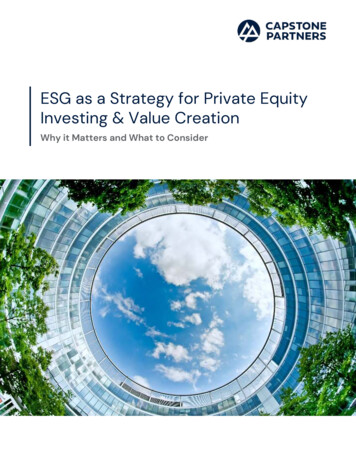
Transcription
ESG as a Strategy for Private EquityInvesting & Value CreationWhy it Matters and What to Consider
ESG as a Strategy for Private EquityInvesting & Value CreationWhy it Matters and What to ConsiderExecutive SummaryCapstone Partners explores how private equity firms can leverage Environmental, Social, and Governance(ESG) frameworks within their portfolio companies to enhance and create value from inception to exit. ESGinitiatives in and of themselves do not make a poorly performing company profitable. However, when properlyapplied, ESG frameworks are a non-traditional financial analysis and engineering tool that can materiallystrengthen the fabric, flexibility, efficiency, and long-term growth potential of an organization and driveenhanced economic shareholder value.Our featured contributors include the leaders of Boston-based private equity firm The Watermill Group, ESGand investor communications program provider Library Ave Consulting, and ESG and impact analyticssoftware provider Tablecloth. Collectively, these individuals provide unique perspectives on strategies, tips,and tools for successful ESG integration.BackgroundESG’s relevancy within private capital investing is clear, with ESG-focused assets under management (AUM)accounting for more than one-third (approximately 3.1 trillion) of committed capital in 2021, according toPrequin.1 Of this, private equity accounted for the largest asset class, with 1.82 trillion invested in ESG funds.Investor demand was the primary reason that fund managers reported implementing ESG strategies,particularly amid mounting political pressures for private equity fund transparency and ESG reporting.The COVID-19 pandemic has been a notable driver of ESG awareness in the U.S., as organizations wererequired to find an appropriate balance between employee health and safety and company productivity.Work from home and the Great Resignation also brought to the forefront a long-needed reset of thetraditional business landscape and factors such as a corporation’s social responsibility, its role in thecommunity, impact on the environment, and adherence to recommended guidelines were more closelyscrutinized. In a survey of its portfolio companies, TPG Capital noted that in addition to an increased focus onhealth and safety, social capital, and environmental initiatives, the uncertainty of COVID-19 also catalyzedenhanced risk management—yet another asset of a well-run ESG strategy.2This paper explores the multifaceted definition of ESG, why the topic is relevant for every firm to consider,hurdles and upcoming changes the industry will likely face, and how to approach ESG integration. Despite itsconnotations, ESG is not a synonym for altruism, but rather, it is a strategy for optimizing a business andinvestor returns.2
ESG as a Strategy for Private Equity Investing & Value CreationTaking Stock of Responsible InvestingESG in the Culture WarsMy mother recently asked me if I was “doing ESG now.” She had heard the term from a talk radiohost who conflated corporate ESG initiatives with progressive political activism. Her question wasreflective of the general tendency to reduce the broad and nuanced range of ESG issues to twosignature items: carbon emissions reduction and the concentration of people of color and womenon corporate boards and in C-suites (d/b/a Diversity, Equity and Inclusion – DEI). These topics, whileimportant, are only part of the complex and increasingly relevant ESG landscape.To be clear, ESG advocacy is not the lunatic fringe of the woke left run amok in corporate boardrooms. Rather, this arena has attracted a passionate group of practitioners, who have made it theirmission to help investors and company managers employ frameworks to measure non-economicbusiness impacts alongside more traditional financial underwriting and value creation techniques.My favorite exhibit in this piece follows on pages five and six. Flip ahead to see the myriadconsiderations business leaders face as they build organizations across 12 industries covered byour Investment Banking Team. The staggering range of issues understandably tempts a focus on afew flashpoint items like carbon reduction rather than embrace the other layers of sensiblecorporate governance.Nuthin’ but a G ThangWith the breathless focus on emissions and workplace diversity, the “G” of ESG–corporategovernance—often gets short shrift in the conversation. (Corporate governance includes, but is notlimited to, organizational transparency, risk management, anti-corruption, executive compensation,board independence, and privacy issues). Sure, the editorial pages can spar over the emissions ofan oil major or the racial/ethnic makeup of a Fortune 100 board, but for many of the family andentrepreneur-owned businesses that we represent at Capstone, having a board populated by nonfamily members and endowed with decision making power can be a novel concept. Proper boardgovernance can shine a spotlight on existential issues that a business must face as itprofessionalizes and accepts outside capital. For instance, in the era of state-sponsored hackingand data theft, cyber security policies and user data protections play a crucial role in protecting acompany from scandal. Firms that neglect to develop these policies have likely not contemplated3
ESG as a Strategy for Private Equity Investing & Value CreationTaking Stock of Responsible Investing (Continued)the true cost of an event and, knowingly or otherwise, invite risk on a not if, but when basis. An ESGtune-up prompted by an institutional investor can be the long-needed kick-in-the-pants that abusiness owner needs to get the governance house in order.Mega Funds Lead the WayInterestingly, the private equity mega funds have led the charge in ESG adoption and the middlemarket funds are falling in line behind them. As you’ll see in the pages that follow, firms like Carlylelaunched initiatives over a decade ago and now have mature ESG programs. They committed thecapital and human resources even before the LPs made robust ESG programs a condition ofcontinued funding. In the middle market, LPs haven’t historically held GPs accountable to tangibleESG standards until recently. Now a tidal wave of ESG best practices adoption is underway in themiddle market.Harder, Better, Faster, StrongerIn our view, the adoption of ESG initiatives in the private equity industry is part of a larger trend: theonly way managers generate outsize returns in the buyout business in 2022 is by making portfoliocompanies dramatically bigger and better. The era of financial engineering in private equity is deadand buried. Print the obituary. So, let’s call ESG exactly what it is: a playbook that systematicallymakes a business better. A better employer. A better risk manager. A better custodian of customerand patient data. A better steward of our environment. A firm that is more rooted in its market andcommunity by creating better economic opportunities for every stakeholder. Of course, there areskeptics. Some managers do not accept as gospel that ESG adoption produces superior financialreturns. Many more simply acquiesce to the cynic’s Golden Rule (whoever has the gold makes therule) and accept that ESG reporting is the price of raising capital from an institutional investor. Timewill tell whether GPs turn good ESG hygiene into cold hard cash and cement these principles intoM&A diligence forever.Thank you for reading our report. We hope that the contents within provoke thoughtful discussions,and that you will pick up the phone and share your feedback with us.Take care of yourself and takecare of someone else,Brendan BurkeManaging Director,Head of Sponsor Coverage4
ESG as a Strategy for Private Equity Investing & Value CreationWhat is ESG?While ESG is fairly nascent to the U.S. middlemarket, it has been prolific in Europe and Canadaand has become an increasingly mainstream topicamong large U.S. corporations. Within the privateequity universe, ESG adoption has graduallyincreased, but has been stunted by the lack ofuniform metrics, standard integration practices,and publicly available financial results. The officialterm “ESG” was coined in the 2004 United Nations(U.N.) paper “Who Cares Wins: ConnectingFinancial Markets to Changing the World,” whichgathered recommendations from analysts,financial institutions, companies, investors, pensionfund trustees, consultants and advisors, regulators,stock exchanges, and non-governmentorganizations (NGOs) to increase awareness of thetopic’s importance across all financial markets.3While ESG has frequently been sequestered torefer only to Environmental issues, the Social andGovernance aspects of the acronym are farreaching and include everything from Diversity,Equity, and Inclusion (DEI) to workplace safety, andanti-corruption policies.ESG measures are an effective prism throughwhich every firm’s management and investmentstrategy should be viewed to strengthen itscompetitive advantages, reduce regulatory andlitigation risks, attract top talent, and increaseoperational efficiencies. Furthermore, byimplementing ESG initiatives companies, whetherpublic, private, or private-equity backed, can bebetter positioned to differentiate themselves toattract capital and maximize their value in aliquidity event. Buyers are becoming increasinglyattuned to the importance of ESG as riskmitigation and as a tool for identifying areas ofgrowth and innovation. Because of this, assessing atarget's ESG-related value and risks is becomingstandard in corporate and merger and acquisition(M&A) due diligence. In this light, by consideringthe full ecosystem that a company touches, thereis collinearity in ESG and financial performance,where ESG integration helps to achieve long-termvalue creation.ESG considerations will vary between industriesand across sectors and may not always bepresented specifically under the auspices of themultifaceted ESG terminology. Scrutinized topicsfalling under the ESG umbrella include employeeretention and engagement; workforce diversity;geopolitical risks; ethical supply chains; workplacesafety; and data privacy. When a holisticunderstanding of the term is embraced, itbecomes clear that all aspects of having afavorable ESG profile are part and parcel with whatit means to do good business.ESG Overview by Key CriteriaESG initiatives can support businesses’ resilience from internal and external shocks, decreasing potentiallegal issues while increasing the attractiveness of the company to employees, investors, and shareholders.Environmental Water use/ConservationSustainable NaturalResources/AgricultureWaste ReductionClean TechnologyClimate ChangeCarbon EmissionsReductionGreen BuildingSocial Workplace SafetyLabor RelationsWorkplace idance of Tobacco/Harmful ProductsHuman RightsGovernance Corporate PoliticalContributionsExecutiveCompensationBoard DiversityAnti-Corruption PoliciesBoard IndependenceRisk ManagementTransparencySource: Capstone Partners5
ESG as a Strategy for Private Equity Investing & Value CreationSample of ESG Factors by IndustryESG considerations are integral to the innovation and growth of companies across every industry. The tablebelow showcases recurring ESG themes as noted by Capstone’s Investment Banking Team.IndustryEnvironmental AEROSPACE, DEFENSE,GOVERNMENT &SECURITY Alternatively-poweredaircraftSustainable and ethicalsupply chainAircraft engine emissionsregulationRecycling ofdecommissioned assetsSocial BUILDING PRODUCTS &CONSTRUCTIONSERVICESBUSINESSSERVICES Energy efficient buildingsWater efficiencyWaste & hazardousmaterial management Energy prices fordatacenter dependenceTravel efficiency forconsulting services CONSUMER& RETAIL EDUCATION& TRAINING ENERGY& POWER Ingredient sourcingRecyclable packaging andmaterials & plasticreductionSupply chain due diligenceOnline educationalresourcesPublic school energyefficiency ratingsReducing greenhouseemissionsToxic emissions & wasteLand and aquafercontaminationInvesting in shift to greenenergy GovernancePublic safetyTalent diversity and agingworkforceReputational risk ofweapons manufacturing &complicity in the MilitaryIndustrial ComplexWorker safetyConsumer demand forgreen productsCommunity awarenessDiversity, equity,inclusion-basedrecruitment Privacy and security ofpersonal & corporateinformationIdentity protectionTransparency andconsistent disclosuresSustainability focusedleadershipUnbiased human resourcepractices & recruitmentAdvertising integrity Data privacyEnvironmental consultingservicesHumane & safe workingconditionsProduct labeling Consumer privacyProduct safetyEmissions standardsEducation quality & gainfulemploymentMarketing practices Diverse board of directorsEducational institutions’code of ethics Explicit emissionsreduction targetsClimate risk awarenessHealth & safety of workersLocal politics & regulationand taxationIncreased energy demandfor communities(affordability & reliability) Source: Capstone Partners and S&P Global6
ESG as a Strategy for Private Equity Investing & Value CreationSample of ESG Factors by Industry (Continued)IndustryEnvironmental FINANCIALSERVICES HEALTHCARE INDUSTRIAL INDUSTRIALTECHNOLOGY TECHNOLOGYMEDIA & TELECOM Digital solutions to reducecarbon footprintLending & investment tosustainable sectorsIncreased frequency &severity of weather events(insurance)Socially responsiblesupplier partnershipsPackaging material &wasteEnergy intensity forBioPharmaWaste & hazardousmaterial managementRecycling of inputmaterialsEnvironmentally-friendlyequipment andbusinesses practicesEfficiency through artificialintelligence and big dataRenewable energytransitionEco-conscioustransportationData center operationManufacturingdependency on waterusage and mineralsSocial TRANSPORTATION& LOGISTICS Reducing carbonemissionsEfficient uses of land forwarehousingPackaging material &wasteDemocratization oflendingSocially inclusive financialecosystemSocially responsibleinvestingServing unbanked regionsEqual access tohealthcareProduct safety & recallsMisleading marketing Customer privacyTransparency and ethicalbanking activity Patient privacyCommunity healthassessmentsValue-based careAccessible medicalrecordsSelling practices Improving qualitystandardsIncreased safety ofcapital assetsOccupational health &safetySupply chain transparency Improved job securityCapital maintenanceeducation Cyber threat mitigationEnergy managementanalytics Gender & ethnic diversityEliminating hiring & paybiasBuilding AI withoutsystematic biasesFunding for female &minority STEM programsSocial giving User privacy & datasecurityAntitrust disputesData security Governance Driver working conditionsEmployee retentionAccident & safetymanagement Transportation networkregulationLogistics auditsSource: Capstone Partners and S&P Global7
ESG as a Strategy for Private Equity Investing & Value CreationESG As Value CreationPrivate equity firms have increasingly turned tothe ESG playbook as a valuation creation lever andrisk mitigant throughout the investment cycle.Attracting Limited Partner (LP) funding todayfunctionally requires an ESG program. Seventypercent of LPs surveyed reported that ESGconsiderations are included in their investmentpolicy, according to Bain & Company’s GlobalPrivate Equity Report 2022.4 Furthermore, 93% ofLPs noted that they would walk away from aninvestment with poor ESG metrics. In NorthAmerica, the chief reason to avoid an investmentin a company with ESG concerns was the risk ofnegative publicity (72%) while in Europe it was thelack of the target company’s desire to improve itsESG performance (78%). Portfolio investments areincreasingly being scrutinized by General Partners(GPs) in the due diligence phase for their ability toalign with ESG-related investment criteriabaselines, material risks, and value creationpotential. Seventy-three percent of LPs noted thatGPs’ use of an ESG risk factor framework inacquisitions and the management of portfoliocompanies was moderately to extremelyimportant when deciding whether to commitcapital to a fund, according to a 2021 PitchBooksurvey.5 The ultimate evidence for ESG initiativesare higher financial returns. There are clearinstances of this, in which ESG efforts manifestthemselves in operational improvements. In ananecdote that Lauren Winkler, Founder & ManagingPartner of Library Ave Consulting, shared in anexclusive Capstone interview, a manufacturingcompany in South Dakota retrofit its facility toaddress pollutant and emission issues and buoyedthe company’s EBITDA by 3 million dollarsannually through improved efficiency. By using anESG lens to make operational improvements,forward-looking strategies to monitor, optimize,and innovate throughout an investment’s holdingtime can further enhance shareholder value anddrive a higher rate of return upon exit.When analyzing more than 1,000 research paperson ESG and financial performance, NYU Sternfound that the majority of ESG initiatives had apositive effect on operational metrics includingreturn on equity (ROE), return on assets (ROA), andSix Themes on ESG &Financial Performance1.Improved financial performance from ESGinitiatives becomes stronger over longerperiods of time.2.ESG integration performs better than anegative ESG screening approach.3.ESG investing can provide downsideprotection during market volatility.4.Corporations drive improved financialperformance from ESG adoption from riskmanagement and innovation.5.Managing for a low carbon futureimproves financial performance.6.Mere ESG disclosure does not improvefinancial performance.Source: New York University Sternstock prices, according to the 2021 releasedstudy.6 At the same time, the analysis concludedthat there has been a lack of proper distinctionbetween research on differing investmentstrategies and asset classes.While empirical evidence is still being gathered toprove out the model for private equity ESGinvesting, several industry leaders have beentrailblazers in its exploration. The Carlyle Group(Nasdaq:CG) was one of the earliest ESG adoptersreleasing its first annual ESG report in 2010. Thefirm tracks material performance indicators acrossits portfolio companies and hosts an annualSustainability Workshop for the companies toguide in problem solving and information sharing.TZP Group launched its ESG 360 program in 2020with a key objective being to lead other lowermiddle market firms. TZP developed a playbookand has sought ESG integration from sourcing, todeal execution, to post-investment initiatives.These firms, among many others including thosehighlighted on the following pages, can serve as aguide for organizations that are exploring the valueof ESG integration and are at the cusp of adoption.8
ESG as a Strategy for Private Equity Investing & Value CreationPrivate Equity Firms Pioneering ESG InvestingMany leading private equity firms have adopted ESG programs and have raised and invested capital in impactfunds. The examples below can provide insight into understanding and approaching ESG integration.Integration Highlights: In 2010, The Carlyle Group released its firstannual ESG report, in 2020 it was one of the first firms to publish a TaskForce on Climate-related Financial Disclosures (TCFD) report, and in2022 it led the first PE partnership to standardize ESG reporting. Thefirm has more than 20 billion in ESG-related financings and regularlyimplements ESG strategies at its portfolio companies with key programssuch as vision workshops, materiality assessments, and gap analyses.AUM: 376.0 BillionDry Powder: 39.3 BillionActive Portfolio: 307ESG Investment Themes: Energy Transition and DEIPortfolio Example: Carlyle acquired IRCA (Italian producer of specialtydessert ingredients) in June 2017 and completed a 12-week workshopwith the company, ultimately establishing ESG goals for DEI, energy andcarbon emission reduction, and waste management. IRCA sold in April2022 for 1 billion, roughly twice the price Carlyle paid in 2017.Standards & Tools: Task Force on Climate-related Financial Disclosures(TCFD); Sustainability Accounting Standards Board (SASB)Reporting: 2022 Impact ReviewIntegration Highlights: The Blackstone Group (NYSE:BX) has more thana decade-long history of ESG integration and conducts an annual ESGsurvey and quarterly data collections from its portfolio companies. In2021, Blackstone acquired ESG software and consulting service Spherafor 1.4 billion to further the firm’s strategy.ESG Investment Themes: Decarbonization, Good Governance, DiversityAUM: 915.0 BillionDry Powder: 115.1 BillionActive Portfolio: 457Portfolio Example: Blackstone acquired dating platform Bumble (nowNasdaq:BMBL) in 2019 and helped achieve CEO Whitney Wolfe Herd’sgoal to build a women-led C-suite. In 2021, Herd became the youngestwoman entrepreneur in the U.S. to take a company public at the age of31 and became the world’s youngest self-made female billionaire.Standards & Tools: U.N. Principles for Responsible Investment (PRI);Task Force on Climate-related Financial Disclosures (TCFD); Taskforceon Nature-Related Financial Disclosures (TNFD); American Council onRenewable Energy (ACORE); ESG RepRiskReporting: 2021 ESG Update: An Integrated Approach to ESGSource: PitchBook, Company websites, Capstone Partners9
ESG as a Strategy for Private Equity Investing & Value CreationPrivate Equity Firms Pioneering ESG Investing(Continued)Integration Highlights: Kohlberg Kravis Roberts (NYSE:KKR) launched itsGlobal Impact Fund in 2018. The firm has made 15 ESG portfolioinvestments including six in 2020 and three in 2021.ESG Investment Themes: Climate Action, Lifelong Learning, SustainableLiving, Inclusive GrowthAUM: 429.0 BillionDry Powder: 104.6 BillionActive Portfolio: 424Portfolio Example: KKR acquired majority stakes in Emsi and BurningGlass and merged the companies in June 2021 to create a leading labormarket analytics company that promotes opportunity, mobility, andequity across the workforce.Standards & Tools: U.N. Sustainable Development Goals (SDGs);Principles for Responsible Investment (PRI); Sustainability AccountingStandards Board (SASB); Task Force on Climate-related FinancialDisclosures (TCFD)Reporting: KKR Global Impact Fund Overview and Highlights from the2020 Limited Partner Impact ReportIntegration Highlights: TPG (Nasdaq:TPG) adopted an ESG policy in2012 and raised 2.1 billion for its first impact investing platform, The RiseFund, in 2017. TPG now has several investment platforms and hasinvested in 68 companies as of 2021. The firm launched Y Analytics in2018, to study the net financial gain of social and environmental impactinvesting to inform its valuation methodologies and optimize outcomes.AUM: 114.0 BillionDry Powder: 28.2 BillionActive Portfolio: 253ESG Investment Themes: Climate Change, Diversity, Equity, & Inclusion,Creating Innovative Investment PlatformsPortfolio Example: TPG acquired promotional products distributorHALO Branded Solutions in 2018. The company’s policies ensure sociallyresponsible supply chain management and sustainable sourcing.Standards & Tools: U.N. Principles for Responsible Investment (PRI);Sustainability Accounting Standards Board (SASB); Taskforce forClimate-related Financial Disclosures (TCFD)Reporting: 2020-2021 ESG Performance ReportSource: PitchBook, Company websites, Capstone Partners10
ESG as a Strategy for Private Equity Investing & Value CreationCase Study: Q&AJulia KarolPresident & COOThe Watermill Group is very much a familylegacy, can you share some of that history?Karol: The firm started in 1978 with my father andmy grandfather and they started doing what wascalled ‘bootstrap acquisitions.’ At that time privateequity was really a new concept and investing inbusinesses and using leverage to buy thebusinesses and add value wasn't very common.One of my favorite anecdotes is that they put anadvertisement in the paper that read: ‘Do YouWant to Sell Your Company?’ And they got anumber of responses. At the time, the businessesthat were largely available and needed supportwere manufacturing businesses, so we developedan expertise in that.The other thing that was happening around thenwere these new concepts of corporate strategyand business strategy. They were just starting tocome out of Harvard and the consulting firms werejust starting to grow and use them. So, wedeveloped a strategy focused competencysimultaneously because we needed the capabilityof supporting companies through strategictransformation. Today, we are still family led andwe continue to focus on industrial businesses,although not exclusively.Capstone is exploring ESG and how PE firms canintegrate these measures into their investmentthesis. You’ve done that in very real way. Canyou tell us what led you to launch WMX?Karol: The reason we started researching genderdiverse companies came from the MeToomovement. When it started gaining traction, theventure capital world responded quickly and putAnabelle SkallebergPrincipalWatermill Group WMX FundAs a woman-led firm, the Watermill Group hascommitted to using its seat at the table to makespace for more companies with high growthpotential, creating access to the capital andresources smart leaders need to thrive. With acommitment to help accelerate the demographicand cultural transformation underway around theworld, the WMX initiative widens the path forthese vital shifts to take hold in the Private Equityindustry. Watermill is leading the change bymaking investments in great teams led by womenwith a vision to build enduring businesses. Thegroup supports WMX-funded leaders with avibrant circle of trusted funders, advisors, andpartners wholly dedicated to the collectivesuccess of all stakeholders.Investment Criteria:Size 20 million to 200 million in revenues.IndustriesWhile Watermill is backed by deep expertise inIndustrial Manufacturing and Value-AddedDistribution, the fund pursues investments acrossa range of industries.BoardWMX seeks control investments in dynamicbusinesses that are owned or led by a woman, orhave at least one woman in the c-suite. Watermillis flexible about percentage of ownership, makingthem an ideal partner for teams looking to retaina meaningful portion of their equity.Source: The Watermill Group11
ESG as a Strategy for Private Equity Investing & Value Creationtheir money where their mouth was. Suddenly, youstarted seeing new early stage seed investors orVC [venture capital] funds founded immediatelyfollowing the MeToo movement. It was exciting andit was important, not just for women but for peopleof color or members of the gay community. Wewere sort of waiting for that to happen in privateequity, and it just didn't happen. That's where werealized that we could be the ones to pivot. That'swhen we started researching and we did a lot ofqualitative and quantitative research.What were some of your key research findings?Karol: We found that a lot of women didn't evenconsider private equity to monetize theirachievements because the industry has areputation for being inaccessible to women. Forthose who did choose to explore it, they foundthat they weren't being heard by the investmentbanking community; they or their teams weren'tbeing taken seriously. So that was the next hurdle,to go through an intermediary that sees the valueof your company and is willing to communicatethat to a market. Thankfully, I believe that'schanged. And the final step in the sales process istalking to private equity firms and feeling like thepeople across the table understood your visionand your culture and the relevance that culturehas on building your company. All those thingsmust come together in a sales process if you arean entrepreneur, and we found that none of themwere coming together at the time.Traditionally, Watermill Group focuses oninvestment in Industrial Manufacturers. That’snot a sector where you would expect manywomen-led diverse businesses. Did youexperience pushback?Skalleberg: While Watermill has historicallyinvested in manufacturing and distributionbusinesses, we have expanded our industry focusfor WMX deals. We made the choice to take abroader market perspective not necessarilybecause we got pushback from the industry, butbecause we analyzed the markets with morediverse management teams and identified thosethat were appropriate for this thesis and our skillset. We are very committed to this effort and inorder to execute against it, we expanded toinclude other verticals and we've expanded also toinclude smaller opportunities.How will you define the success of WMX? Whatkey benchmarks or metrics are you tracking?Karol: We want to see the typical benchmarks ofcorporate success like revenue growth and EBITDAmargin improvement. We want to see each of ourcompanies have a strategic plan and hit it. Wewant our companies to be an invaluable supplier totheir customers. Those metrics don't changeregardless of who's running the company. I thinkthat's the most important thing. For every one ofour companies, safety metrics are critical. So, weare always looking at that. We want see that everyBy the Numbers: Why Invest in Diverse Management Teams19% Higher Return on Equity25% More Likely to OutperformCompanies that are run by female CEOs have,on average, a 19% higher Return on Equity(ROE) than their male peers, accordingto Credit Suisse. 7Companies in the top quartile for genderdiversity had a 25% higher likelihood of financialoutperformance than those in the bottom quartile,according to McKinsey & Company. 91.4x More Revenue19% Higher RevenueHighly inclusive companies generated 1.4x morerevenue and were 120% more likely to meetfinancial targets, according to Josh Bersin.8Companies with highly diverse management teamsreported 19% higher revenue than their nondiverse counterparts, according to BCG. 1012
ESG as a Strategy for Private Equity Investing & Value Creationculture
Private Equity Report 2022.4 Furthermore, 93% of LPs noted that they would walk away from an investment with poor ESG metrics. In North America, the chief reason to avoid an investment in a company with ESG concerns was the risk of negative publicity (72%) while in Europe it was the lack of the target company's desire to improve its
